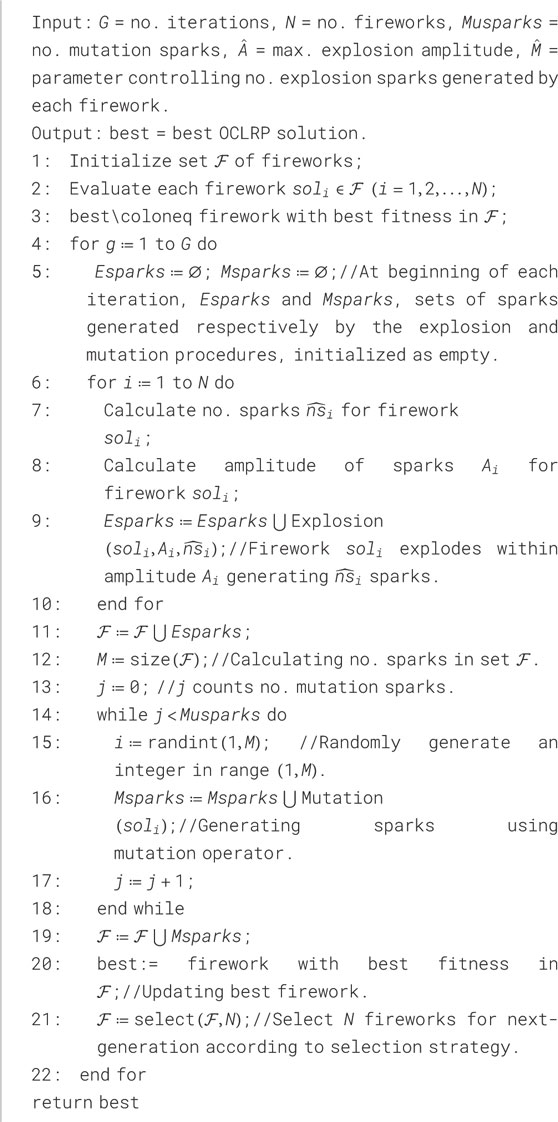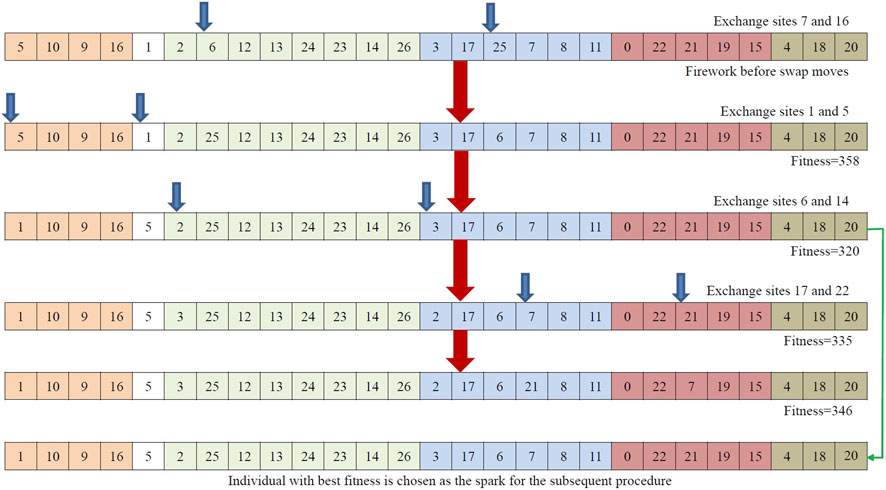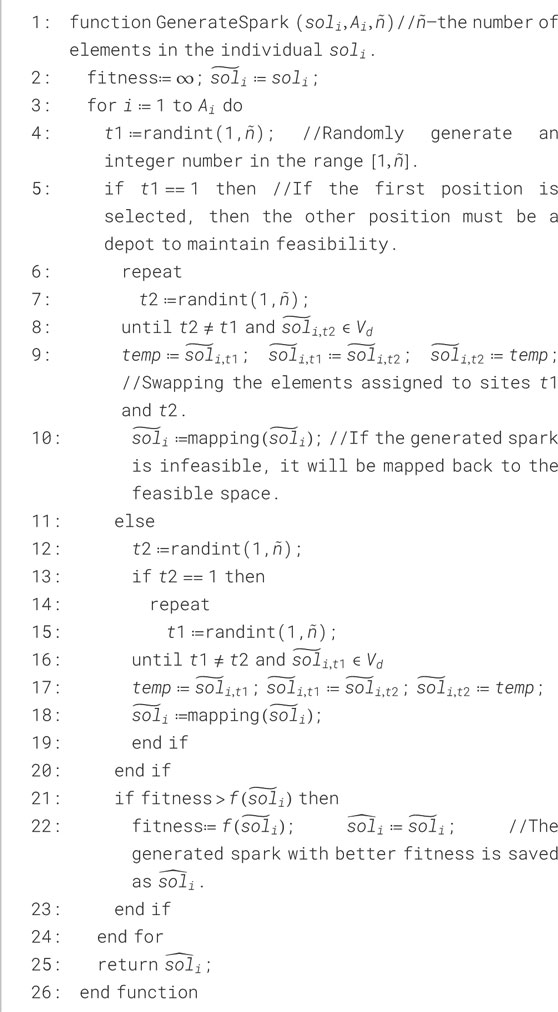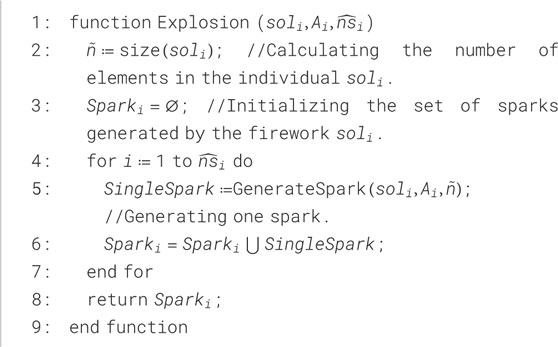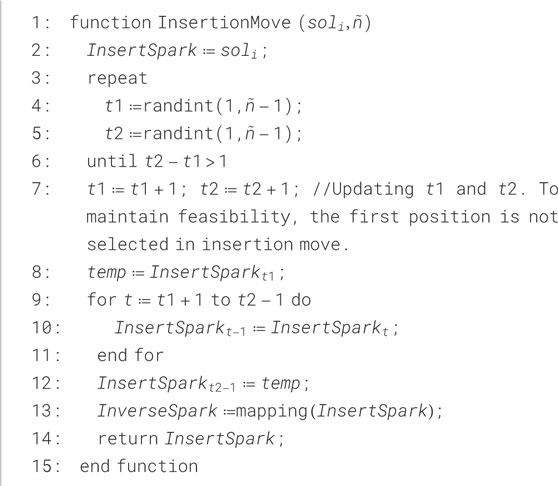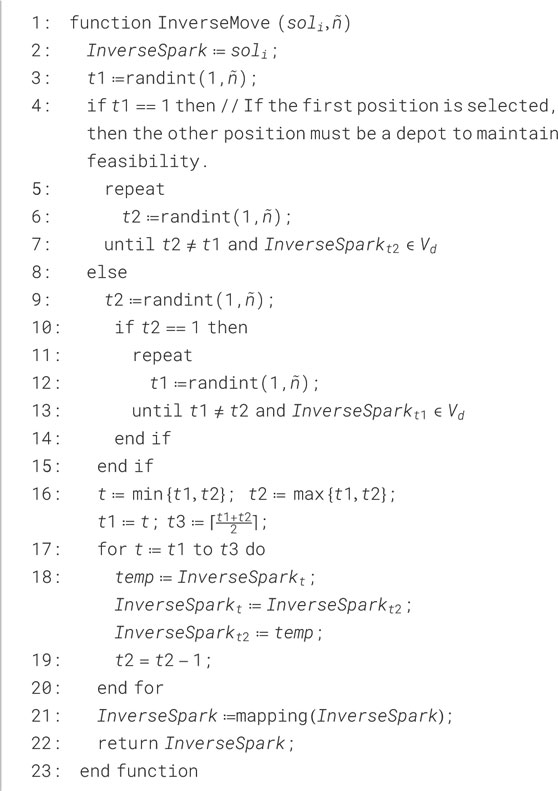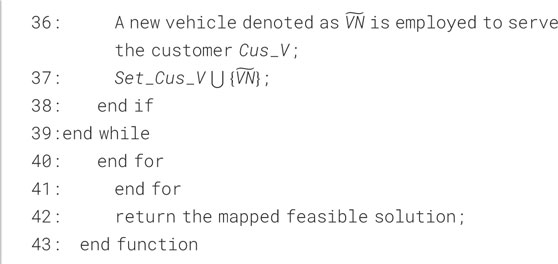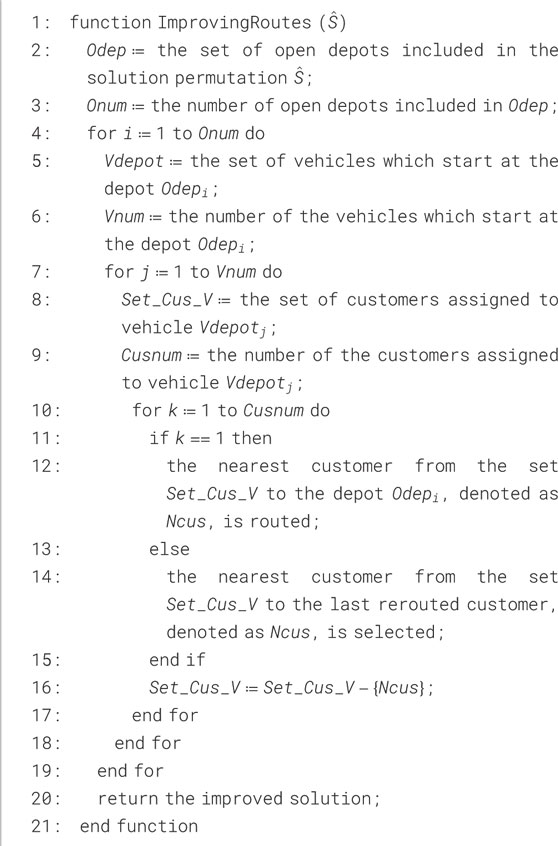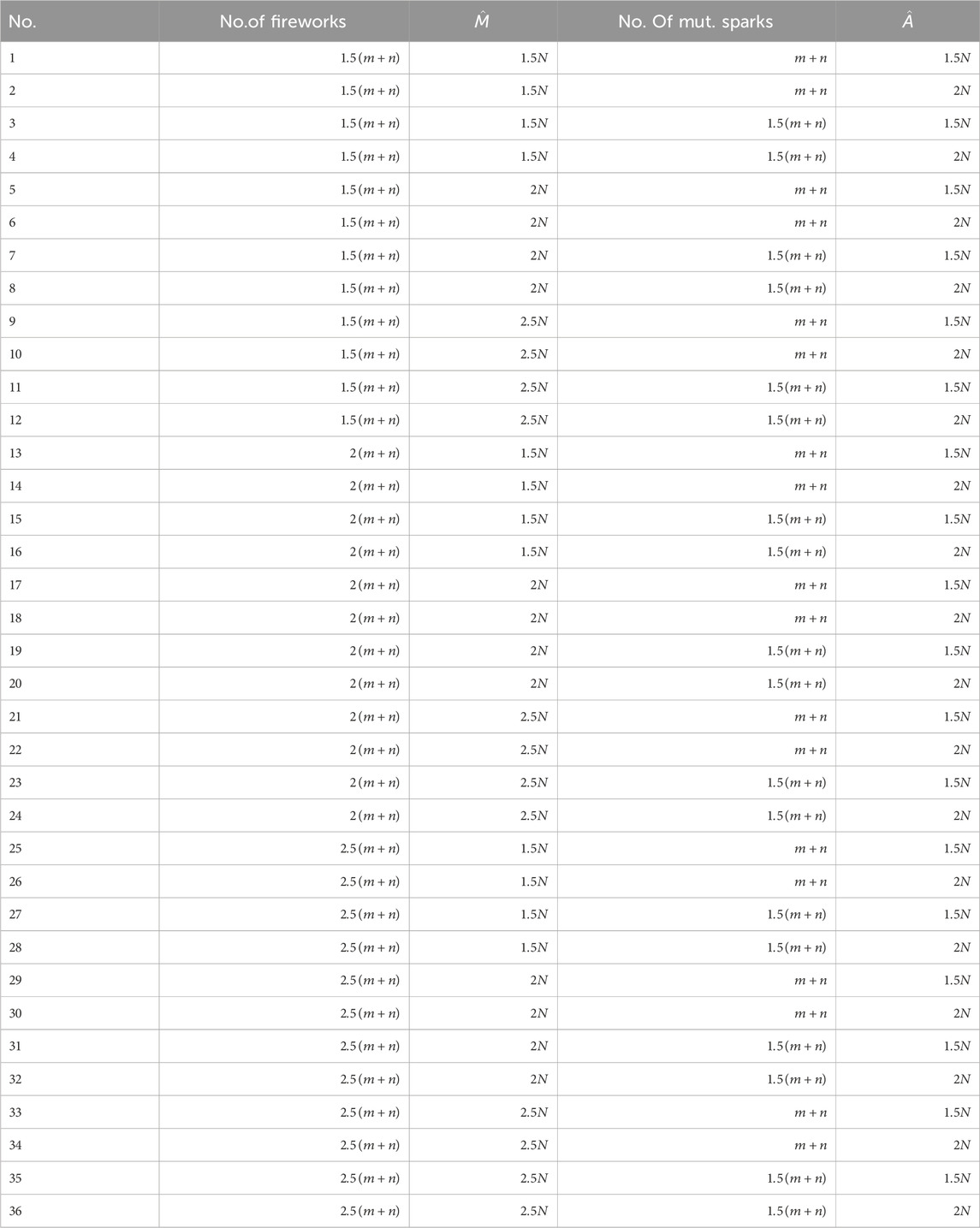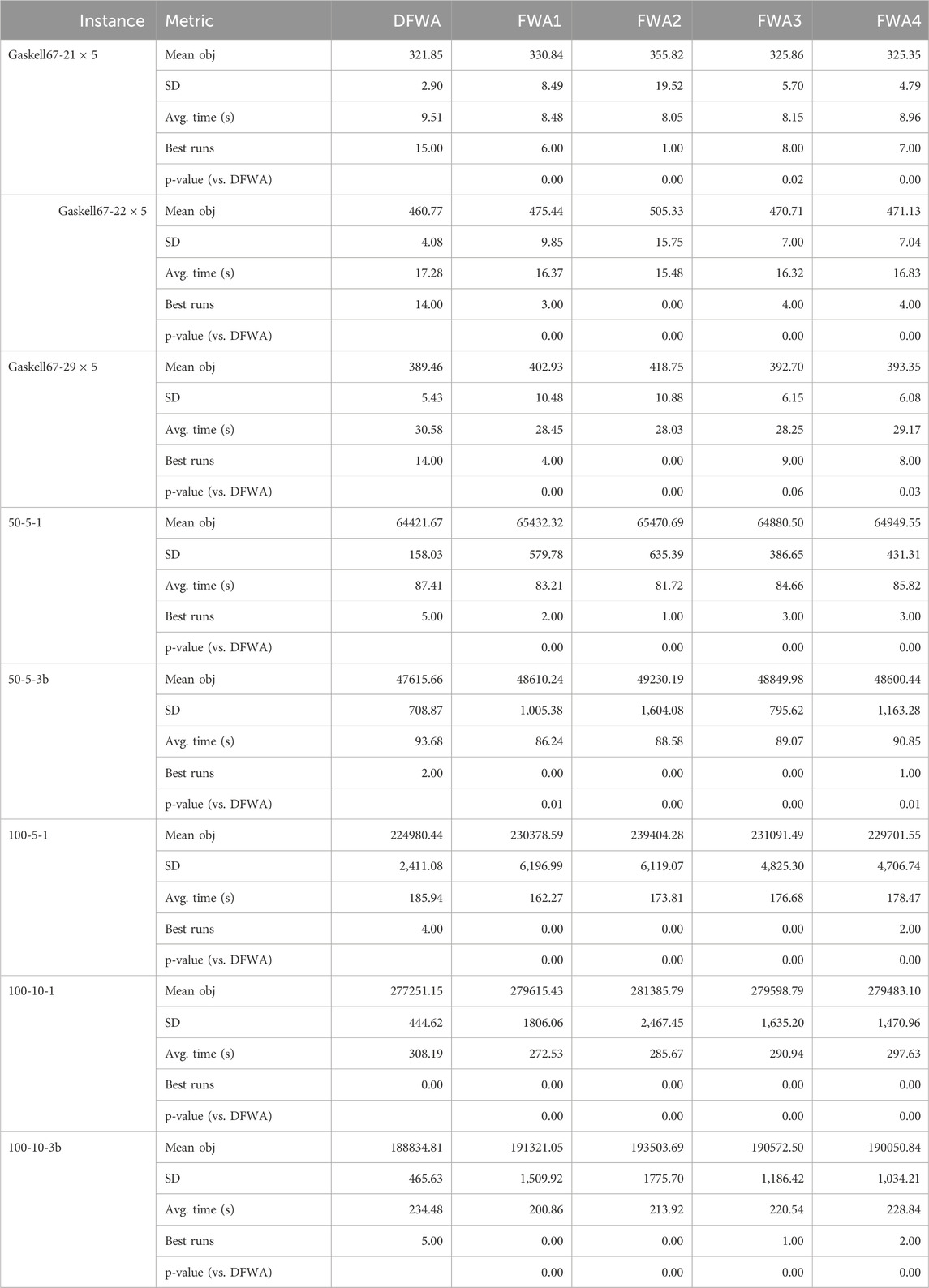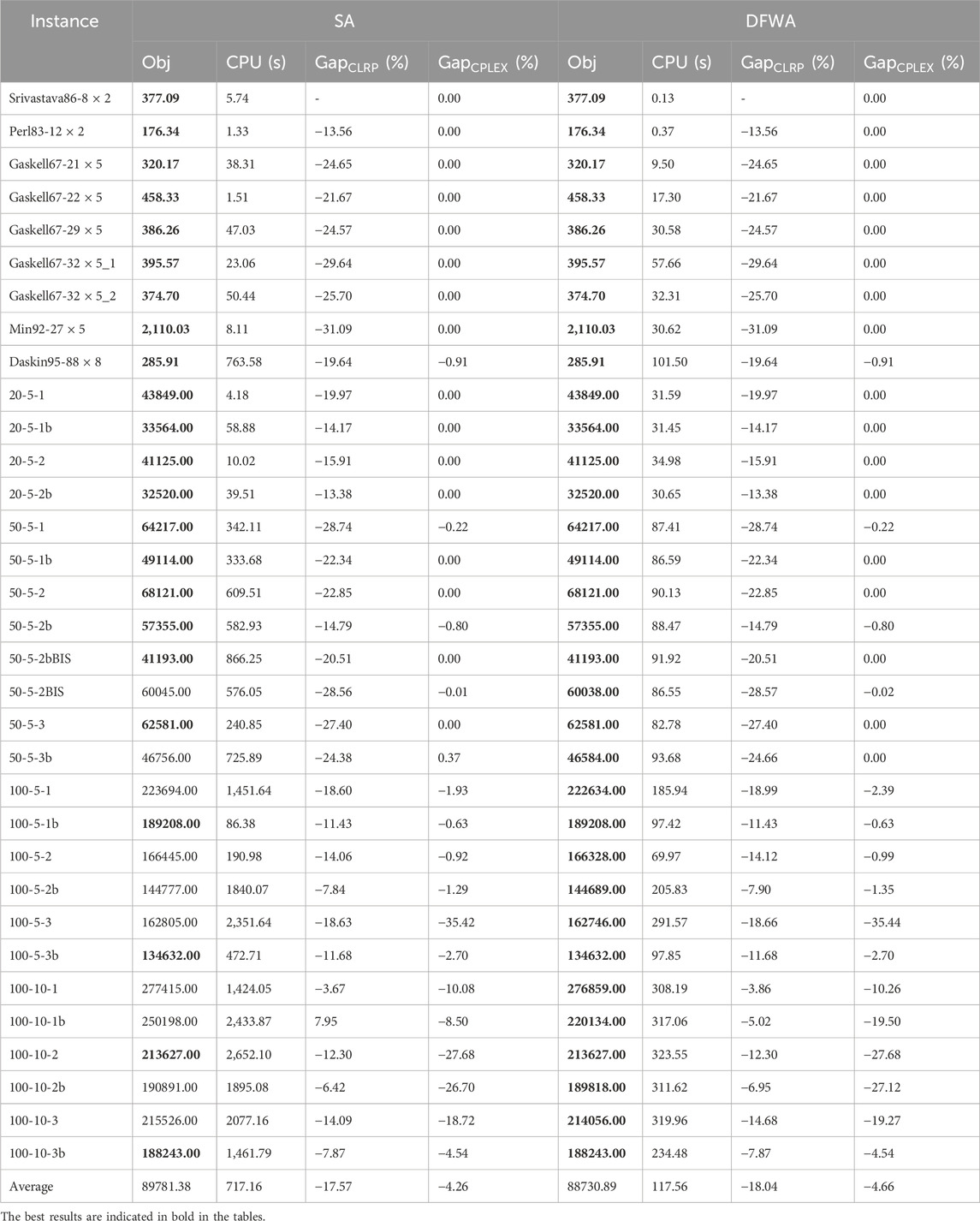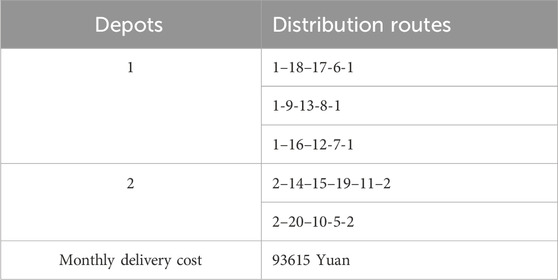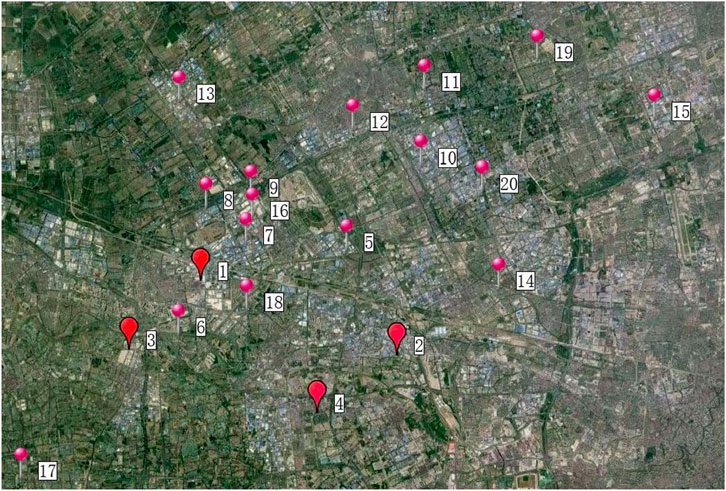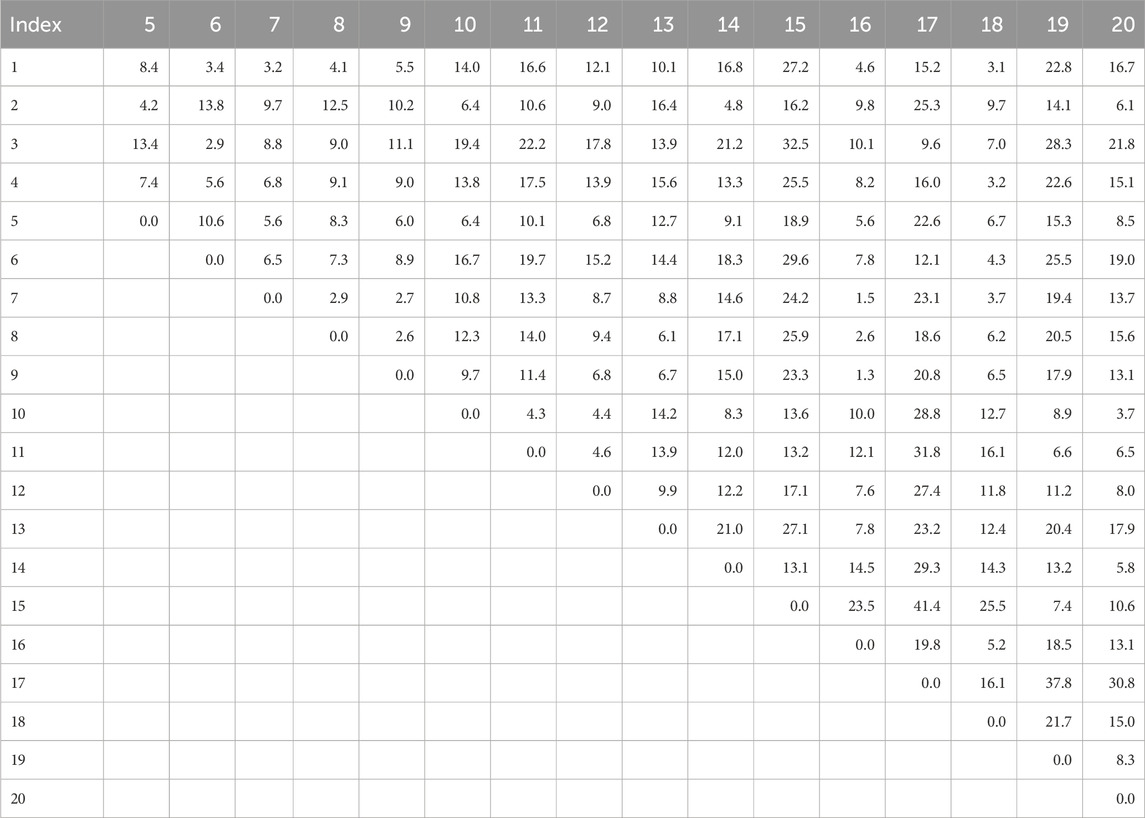- 1School of Management, University of Shanghai for Science and Technology, Shanghai, China
- 2Institute of Mathematical Sciences ICMAT-CSIC, Madrid, Spain
In the open capacitated location-routing problem (OCLRP), a fleet of distribution vehicles departs from selected depots to satisfy customers’ demands, but they do not need to return to their starting depots after serving all customers. Comparing the solutions of the OCLRP and its corresponding capacitated location-routing problem (CLRP) can provide valuable insights for companies considering whether to outsource their delivery activities. To effectively solve the OCLRP, this study proposes a novel discrete fireworks algorithm (DFWA) with two key innovations. (1) An adaptive search mechanism: embedding swap, insertion, and reverse operations into explosion/mutation breaks the limitations of traditional fireworks algorithms in discrete optimization by expanding the search space while enhancing local tuning, thus boosting global optimal solution discovery. (2) A diversified selection strategy: integrating fitness value and Hamming distance improves the “premature convergence from single fitness selection” defect in existing algorithms. It retains high-performance solutions while maintaining population diversity. Evaluated on OCLRP instances adapted from standard CLRP benchmarks, the DFWA shows strong competitiveness, consistently generating high-quality solutions within reasonable computation time. A real-world OCLRP case further verifies its practical applicability in complex industrial scenarios.
1 Introduction
In the current highly competitive economic environment, companies aim for improved supply chain management, including efficient decision-making about depot locations and delivery route design, as these may entail important cost and time savings (Dai, Aqlan, Gao and Zhou, 2019; Zhang et al., 2022b). As a consequence, there is extensive research on both facility location (FLP) (Garcia-Diaz and Smith, 2024) and vehicle routing (VRP) (Niu, Shao, Xiao, Song and Cao, 2022; Zhang et al., 2022a; Garside, Ahmad and Muhtazaruddin, 2024) problems. However, solving these problems as silos may lead to inferior solutions. Location routing problems (LRP) combine both problems and typically lead to more flexible and efficient logistics systems (Mohamed, Klibi, Sadykov, Sen and Vanderbeck, 2022; Yu and Lin, 2015).
A major consequence of the current competitive environment is that companies are increasingly focusing on their core value-added capabilities and activities and tend to outsource their logistics to third-party (TPL) providers (Yu and Lin, 2015). In such cases, TPL provider vehicles usually start their service from the company’s depots (or distribution centers) and return to the TPL installations instead of the depots or distribution centers after delivering to customers; consequently, classic capacitated location-routing problems (CLRPs) are not applicable. To handle these situations, open capacitated location routing problems (OCLRPs) were proposed by Yu and Lin (2015). OCLRPs do not consider the costs associated with the starting trip from the TPL company to its depot nor the return trip from a vehicle’s last customer to the TPL facilities. Thus, the company only considers the costs of locating its depots and those associated with the number of hired vehicles and the trips between depots and the last customer that the vehicle served (Nucamendi-Guillén, Padilla and Moreno-Vega, 2021).
This study provides a novel approach to OCLRPs. We assume that each candidate depot and vehicle have limited capacities and that vehicles return to TPL installations instead of the company’s depots after having served their last customer. OCLRPs simultaneously search for depot locations and vehicle routes to satisfy customers’ demands. The main difference between CLRPs and OCLRPs is that each route in an OCLRP is a Hamiltonian path (vehicles do not return to the starting depot), whereas each route in a CLRP is a Hamiltonian cycle (vehicles return to the starting depot) (Yu and Lin, 2015). Figure 1 illustrates the differences between CLRP and OCLRP solutions in a problem with three depots (triangles), nine customers (circles), and three routes. Both solutions are constructed on a complete directed graph
Importantly, the difference between the solution values of a CLRP and its corresponding OCLRP provides a benchmark to support a company’s decision on whether to outsource delivery activities (Yu and Lin, 2015). While OCLRP and CLRP solutions only differ in the “depot–last customer” arc cost (OCLRP omits this cost), a good CLRP cycle does not guarantee a good OCLRP path; this is because the optimal OCLRP path depends on both inter-customer distances and customer–depot distance, rather than just the closed-loop cost of CLRP. Figure 2 further validates this discrepancy, where 2(a) shows the optimal solution of a CLRP and 2(b) shows the optimal solution of its corresponding OCLRP (both with three candidate depots and nine customers). In Figure 2, depots are marked as triangles and customers are marked as circles. Both 2(a) and 2(b) are built on the same weighted complete directed graph, so that their vertex set, spatial positions of all vertices, and arc costs (straight-line distances) are identical. Solid arcs in Figure 2a form three CLRP cycles, while the red dashed arcs in Figure 2b form two OCLRP paths. This figure helps illustrate that the optimal solution for an OCLRP cannot simply be derived by removing the edge between the depot and the last customer from the optimal solution of the CLRP.
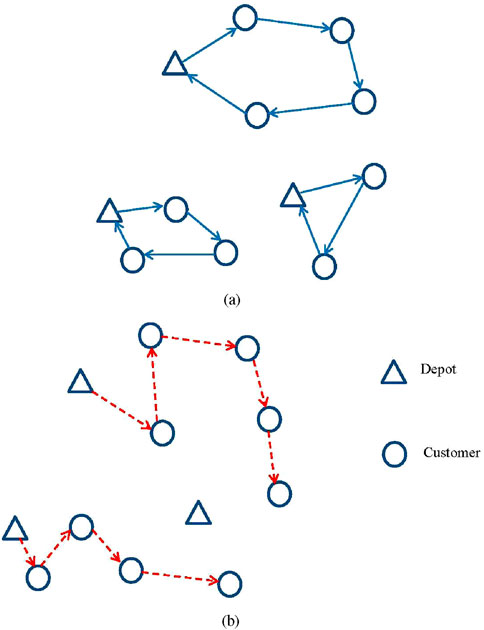
Figure 2. Illustration of the differences between the optimal solutions of a CLRP and that of its corresponding OCLRP. (a) Optimal solution of CLRP instance. (b) Optimal solution of OCLRP instance.
As the VRP (Ergao and Mingyong, 2009) and FLP (Garcia-Diaz and Smith, 2024) are both NP-hard problems, so the CLRP is also NP-hard (Dai et al., 2019). Given its important practical applications and high computational complexity, the CLRP has attracted the interest of numerous researchers who have proposed a wide variety of algorithms, including genetic algorithms (Bootaki and Zhang, 2024; Arifuddin, Utamima, Mahananto, Vinarti and Fernanda, 2024), simulated annealing (SA) (Ferreira and Alves de Queiroz, 2022), particle swarm optimization (Kechmane, Nsiri and Baalal, 2018; Wang et al., 2021), tabu search (Kyriakakis, Sevastopoulos, Marinaki and Marinakis, 2022), ant colony optimization (Ting and Chen, 2013), greedy randomized adaptive search procedures (Prins, Prodhon and Calvo, 2006), and memetic algorithms with population management (Shi, Zhou, Boudouh and Grunder, 2022). Moreover, some exact algorithms have been also proposed, based on dynamic programming, column generation (Farham, Süral and Iyigun, 2018), branch-and-cut (Marques, Sadykov, Deschamps and Dupas, 2020), and branch pricing algorithms. In contrast, the OCLRP has received comparatively less attention, and there is still much scope to improve available models and solutions. Nucamendi-Guillén et al. (2021) proposed a multi-start metaheuristic algorithm to solve the multi-depot open location routing problem with a heterogeneous fixed fleet. Yu and Lin (2015) proposed an effective simulated annealing heuristic for solving OCLRPs based on a special solution representation enlarging the search space and facilitating its exploration. Toro, Franco, Granada-Echeverri, Guimarães, and Rendón (2016) took into account current environmental issues and proposed the green open location-routing problem. Nucamendi-Guillén et al. (2021) were inspired by a real case and proposed a multi-depot OLRP with a fixed heterogeneous fleet.
As a variant of the CLRP, the OCLRP retains the same computational challenge. Moreover, existing mainstreams for similar routing problems face notable limitations when adapted to the OCLRP’s unique characteristics (i.e., Hamiltonian path constraints and depot–customer–vehicle coupling). For instance, simulated annealing heuristics such as proposed by Yu and Lin (2015) expand the search space via special solution representation but often stagnate in local optima for large-scale instances (e.g., 100+ customers), as their single-solution iterative update lacks sufficient local exploitation. Genetic algorithms, though widely applied to the CLRP (Bootaki and Zhang, 2024), struggle with the OCLRP’s path-specific constraints, as their crossover operators often disrupt valid route structures, leading to a high proportion of infeasible solutions that require additional repair mechanisms. Even neighborhood-based methods such as adaptive large neighborhood search (ALNS) and tabu search (TS), while excellent at neighborhood exploration for VRPs, lack the targeted handling of the OCLRP’s triple coupling of depot selection, customer assignment, and vehicle routing, resulting in inefficient search processes and suboptimal cost performance.
In contrast, fireworks algorithms (FWAs) have shown accurate and consistent performance in complex optimization (Y. Tan and Zhu, 2010; Chen et al., 2019) but are rarely applied to NP-hard combinatorial problems like OCLRP, FLP, VRP, or LRP and their variants. This study aims to fill this gap by proposing a novel discrete fireworks algorithm (DFWA) for solving the OCLRP, motivated by three key advantages of the FWA. First, as a heuristic approach, the FWA provides an effective algorithmic framework that delivers acceptable solutions in reasonable computing time to NP-hard optimization problems (Niu et al., 2022). Second, as a meta-heuristic, it allows the flexible integration of local search operators (Zhang et al., 2019; Tan et al., 2025)—a feature that can mitigate SA’s local stagnation and GA’s infeasibility issues. Third, the performance of FWAs have been found accurate and consistent, and they can achieve competitive results in comparison to other well-known optimization algorithms (Tan and Zhu, 2010; Chen et al., 2019). They have been applied in domains such as multimodal function optimization (Meng and Tan, 2024), radar deployment for UAV swarms defense coverage (Ding et al., 2025), and heterogeneous multi-project multi-task allocation in mobile crowdsensing (Shen et al., 2023), indicating their potential to handle the OCLRP’s complex constraints.
The key contributions of this study are the following. Firstly, it proposes a mathematical programming model for the OCLRP. Second, it presents an efficient DFW algorithm for solving the OCLRP. This entails providing an effective initialization and convenient explosion and mutation operators to respectively enhance the exploitation and exploration of the search space. Third, in-depth numerical experiments are conducted to facilitate parameter choice and evaluate the operational gains obtained using the proposed OCLRP model and DFWA. Such experiments and a real case study clearly showcase the effectiveness of our proposal.
The rest of this study covers the following issues. Section 2 states the details of the OCLRP model. Section 3 proposes and discusses our DFWA. Section 4 then provides an in-depth computational analysis, including a real case study. Conclusions and future research are presented in Section 5.
2 Mathematical model for the OCLRP
We present here the formulation of the OCLRP for which we shall develop an efficient algorithm. A set of customers with known locations is available. Their known demands should be satisfied from a set of depots with known locations and opening costs. For this, there is a fleet of homogeneous vehicles with known capacity. Customers must be serviced once, and only once, by a single vehicle. A route load cannot exceed the vehicle capacity, with each route starting from a depot and ending at a customer. Similarly, the demands allocated to a depot cannot surpass its capacity. The OCLRP is typically formulated to minimize total distribution costs, which cover the costs of opening the depots, the fixed vehicle costs, and the routing costs.
The underlying structure to formulate the problem is a complete directed graph
Sets and parameters:
Decision Variables:
Using the above notation, the OCLRP may be modeled through the following integer linear programming problem:
subject to:
As mentioned, the objective function (1) aggregates the costs of opening the depots, the fixed costs of employing vehicles, and the routing costs. Constraint (2) reflects the fact that customers are serviced only once by one vehicle and that they should have just one predecessor. Constraints (3) and (4) ensure, correspondingly, that vehicle and depot capacities are respected. Route continuity is guaranteed through constraint (5). In turn, constraint (6) models the fact that there should be no connection between any two depots, and constraint (7) that each route ends at the last customer. The group of constraints (8) models the issue that each and any customer should be assigned to exactly one depot, whereas (9) guarantees the fact that vehicles dispatch from depots that are open. Constraint (10) eliminates sub-tours within vehicle routes. Finally, constraints (11)–(13) specify the binary character of some of the variables, and (14) is auxiliary variables.
3 Discrete fireworks algorithm for the OCLRP
To facilitate understanding of the proposed algorithm, we first clarify two core technical terms specific to a fireworks algorithm (FWA). (a) Firework: each firework represents a feasible solution within the search space. (b) Spark: a spark is a new candidate solution generated by applying algorithm-specific operators (e.g., explosion) to an existing firework. Sparks represent potential improvements over the original firework, and their quality is evaluated via the fitness function, which in this study is defined as the OCLRP’s objective function.
Tan and Zhu (2010) and Tan (2015) introduced the FWA for optimization problems, inspired by how fireworks explosions resemble optimal solution searches in swarm intelligence algorithms, with each spark generated by a firework explosion assimilated to a feasible solution. It runs iteratively according to the following scheme until certain stopping conditions are met. For each explosion generation,
We now present a DFWA to efficiently solve OCLRPs. The basic steps of our DFWA for solving the OCLRP are presented as pseudocode in Algorithm 1. The input to the algorithm includes the maximum number
3.1 Representation of OCLRP solutions
A compact solution representation is crucial for efficiently implementing a DFWA. In the OCLRP, it should characterize the customer–vehicle assignment, the chosen depots, and the sequence of customers served by a specific vehicle starting at a given depot. Given
As an illustration, Figure 4 presents a feasible solution of an OCLRP with five depots and 21 customers. Observe that depot 1 is not open (no customers after it). The routes served from the four open depots (2, 3, 4, 5) are
3.2 DFWA initial solutions
We construct a set of good initial solutions by randomly generating the open depots and assigning their customers with a greedy approach that promotes use of the maximum capacity of a vehicle; this initialization process corresponds to line 1 of Algorithm 1 (”Initialize set
Step 1. Randomly generate a permutation
Step 2. Designate
Step 3. If
Step 4. While the number of solutions/fireworks is smaller than the required
3.3 Explosion operator
Based on the
3.3.1 Explosion amplitude and number of sparks
In our DFWA, the explosion amplitude and number of sparks associated with a firework (a feasible solution of formulation (1)–(14)) depends on its fitness (objective function value) through Formulas 15 and 16 (Tan, 2015; Tan and Zhu, 2010)
where
To avoid too many or too few sparks using Equation 15, an upper bound
for properly chosen constants
3.3.2 Generation of sparks
Our algorithm generates a spark from
As mentioned, good sparks suggest closeness to an optimal or near-optimal solution. Thus, the explosion process should preserve features of good solutions, and hence only the best-fit spark is selected from the
Recall that once a move is executed, the new solution might need to be recodified to ensure its feasibility. For example, if the first position is selected for a swap, it should be replaced by another depot.
3.4 Mutation operator
As with other swarm intelligence algorithms, maintaining population diversity is crucial for the efficiency of the DFWA to promote full exploration of the most interesting regions of the search space. Mutation is a major diversification technique employed within swarm heuristic algorithms. It refers to the process of increasing population diversity to mitigate stagnation in unpromising areas and promote the exploration of new search regions by introducing random variations in the individual solutions (Zhang et al., 2022b). In this study, the mutation operator is implemented through two search mechanisms—insertion and inversion moves—which are chosen with equal probabilities. Algorithm 4 presents pseudo-code for the mutation procedure.
3.4.1 Insertion move
This move randomly selects the
3.4.2 Inversion move
Inversion move. This move randomly selects the
3.5 Mapping rule
Some of the generated sparks using the swap move and mutation procedures could be infeasible, and they should be mapped back to the feasible region. Indeed, if a spark generated by a move is infeasible, at least one of the following two cases holds.
Case 1. The resulting customers’ demand assigned to the
Case 2. The resulting customers’ demand served by the
Algorithm 7 presents pseudo-code for dealing with both cases. The random selection mechanism in the mapping rule ensures simplicity and avoids excessive computation for small-to-medium OCLRP instances but may lead to inefficiencies in large-scale cases (e.g., 100+ customers or 10+ depots). Repeated random selections can result in redundant reallocations, such as frequently reassigning small-demand customers or choosing depots and vehicles with minimal residual capacity, thus increasing the need for additional repair steps. To address this issue, two optimized strategies are proposed for future implementation while preserving the core logic of the mapping rule:
1. Residual capacity-greedy selection: for depot-level capacity violations (Case 1), prioritize reallocating the customer with the highest demand from the overloaded depot to an open depot with the largest available capacity; for vehicle-level violations (Case 2), assign the largest-demand customer to the vehicle within the same depot that has the maximum residual capacity.
2. Distance-aware selection: when reallocating, combine residual capacity with routing distance by selecting the depot or vehicle that offers sufficient capacity and the smallest additional travel distance (either from the customer or from the last customer in the vehicle’s current route).
It is worth noting that the current random selection plays a crucial role in maintaining population diversity in DFWA, thus helping avoid premature convergence to local optima. For large-scale problems, a hybrid approach (e.g., 80% greedy selection and 20% random selection) could potentially balance computational efficiency and solution diversity. However, such an approach would require further parameter tuning and validation using large-scale benchmarks (e.g., instances with 200+ customers); this is reserved for future research to avoid complicating the current DFWA framework.
3.6 Improving the routes
For each solution generated using the explosion and mutation operators, the distribution routes included in it are improved using a greedy search method. The customers assigned to the same distribution route may be rerouted in this step. First, for each route, the customer nearest the depot which provides service to it is routed. Next, the customer nearest the last rerouted is selected. This is repeated until all customers assigned to the current vehicle are rerouted. Algorithm 8 presents pseudo-code to improve the distribution routes.
3.7 Selection strategy
Based on the explosion and mutation sparks and the current fireworks,
Prior to calculating the Hamming distance, each candidate
where
Our implementation passes down the individual with the best fitness value down to the next generation. The remaining
From Equation 19, observe that individuals with larger distances and better fitness will have more chances of being passed on to the next generation. Thus, this selection strategy promotes both the good characteristics and diversity of the population. In Equation 19, the quadratic power increases the probability of selecting good individuals compared to the first power. Algorithm 9 presents the pseudo-code implementing the selection strategy.
4 Computational analysis
This section reports extensive computational experiments undertaken to assess the performance of the DFWA proposed to solve OCLRPs. For reasons outlined above, we use the data of benchmark CLRP instances without any adjustment to test our algorithm. Implementation is based on Matlab R2016a, and experiments were conducted on a laptop equipped with an A10-7400P CPU at 3.40 GHz and 4 GB of RAM under Windows 10.
4.1 Parameter setting and sensitivity analysis
It is well-known that the proper tuning of parameters may considerably affect the performance of most meta-heuristic algorithms (Zhang et al., 2022a). In our DFWA case, we carried out experiments with two randomly selected benchmark instances—Gaskell67-21×5 and Gaskell67-29×5 (Yu and Lin, 2015) —averaged over 20 independent runs over each instance, using the average gap with respect to the best known solution, the average computing time, and the average number of runs to reach the best solution depending on the following key parameters: number of fireworks, parameter controlling the number of explosion sparks, maximum explosion amplitude, and number of mutation sparks. Only one parameter was modified at a time.
4.1.1 Number of fireworks
To properly set the number of fireworks, we investigated six different values (0.5, 1, 1.5, 2, 2.5, 3) as multipliers of the number
According to this table, the number of fireworks plays a key role in the performance of our DFWA. When a small number is employed (like 0.5
4.1.2 Parameter
The number of explosion sparks is also a crucial parameter in searching for good solutions. A small number of explosion sparks might not strengthen exploration in a promising search region, decreasing the possibility of obtaining the optimal solution. However, a larger number of explosion sparks typically ends up being very similar to an exhaustive method, greatly increasing computing time. Table 2 presents average results over 20 runs for both instances using different values of
4.1.3 Number of mutation sparks
For the proposed DFWA, properly balancing exploration and exploitation critically depends on choosing a suitable number of mutation sparks. A small number hinders the procurement of the optimal solution as the entailed lower population diversity interferes with escaping from a local optimum toward novel unexplored areas. However, a larger number of mutation sparks resembles a naive random multi-start approach. To select a suitable number of mutation sparks, six different multiples of

Table 3. Average results using different number of mutation sparks for Gaskell67-21×5 and Gaskell67-29×5.
4.1.4 Parameter
In our algorithm, this parameter denotes the maximum swap moves for generating one explosion spark. When
4.1.5 Parameter combinations
We undertook additional experiments to identify good parameter combinations. Table 5 lists the 36 combinations tested, based on those found above, for which ten runs over our two selected Gaskell instances took place.
Table 6 presents the average results for each parameter combination.
A closer look at Table 6 reveals that combination 26 shows marginal advantages in solution quality and success rate—its
In all these preliminary experiments, the best solution obtained by the proposed DFWA could not be further improved after 400 iterations where we had included a maximum number
4.2 Comparative performance
As described, our DFWA was initially based on a greedy initialization and iterated swap, insertion, and inverse moves respectively employed to generate good initial solutions, strengthen local search, and enhance population diversity. To further investigate the effectiveness of the proposed search strategies, we compared it with four alternative DFWAs by solving eight representative OCLRP instances (small-scall: Gaskell67-21
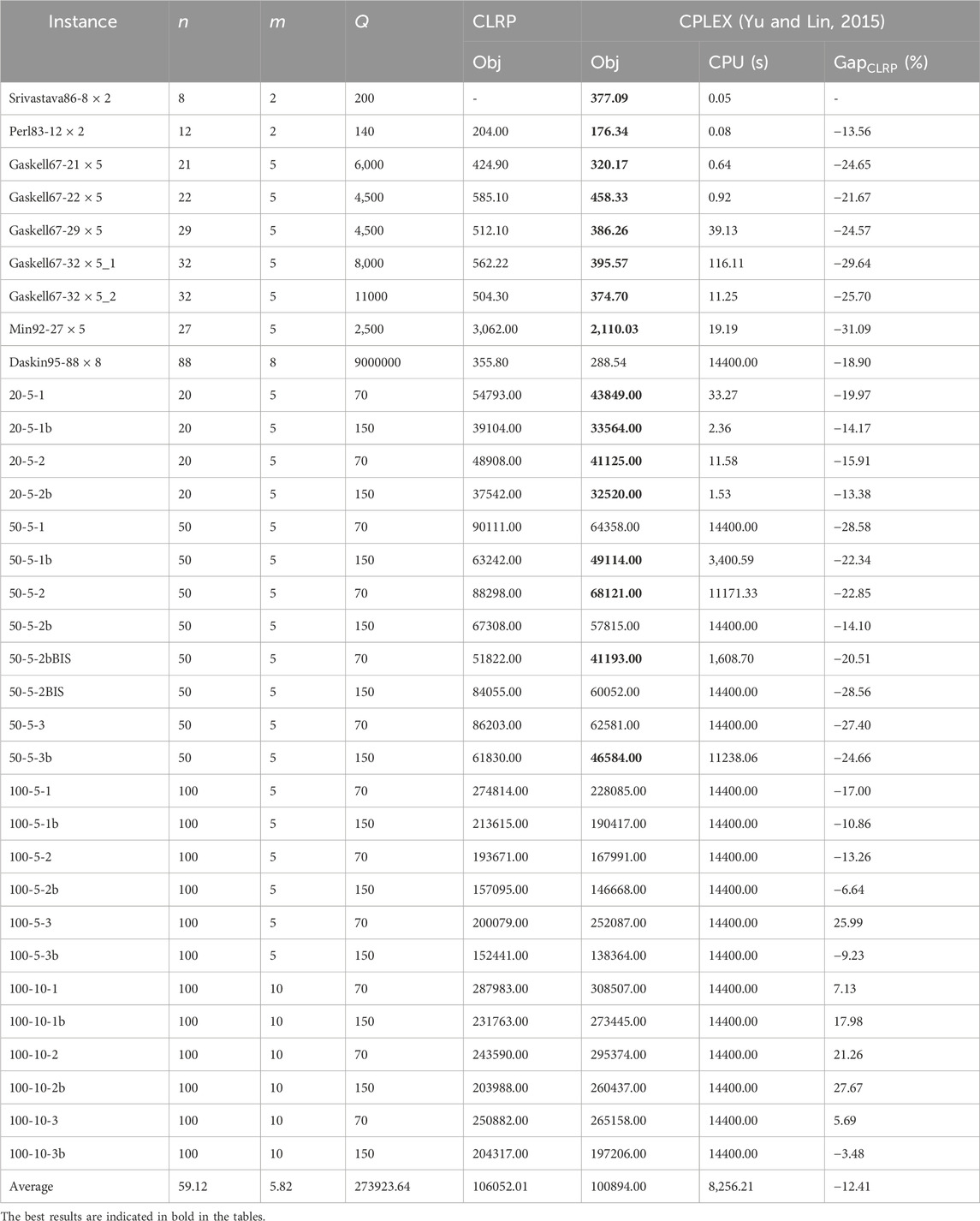
Table 8. Comparison of results with the OCLRP solved with CPLEX and best-known results of corresponding CLRP.
FWA1: initial solution is randomly generated rather than through greedy search. This serves to evaluate whether the proposed greedy approach enhances the overall performance of the DFWA.
FWA2: proposed DFWA except for the iterated swap move imitates the explosion operator, which is removed. This serves to assess the effectiveness of such a move.
FWA3: proposed DFWA except for the insertion move, which is dropped. This serves to assess the effectiveness of the insertion move.
FWA4: proposed DFWA without inverse move, which is therefore assessed.
To ensure a fair comparison, all four alternative algorithms (FWA1–FWA4) adopt the same parameter combination as the original DFWA. No separate parameter tuning was performed for FWA1–FWA4; this eliminates the interference of parameter differences on performance and ensures that any observed gaps in results are attributed to the absence of specific components (greedy initialization, swap/insertion/inverse moves) rather than parameter adjustments.
Table 7 reports the comprehensive performance metrics of the five algorithms over 20 independent runs per instance, including mean objective value, standard deviation (SD) of objective value, average computation time (s), number of runs that found the best-known solution, and p-values (vs. DFWA from Wilcoxon signed-rank test). Except for the instance Gaskell67-
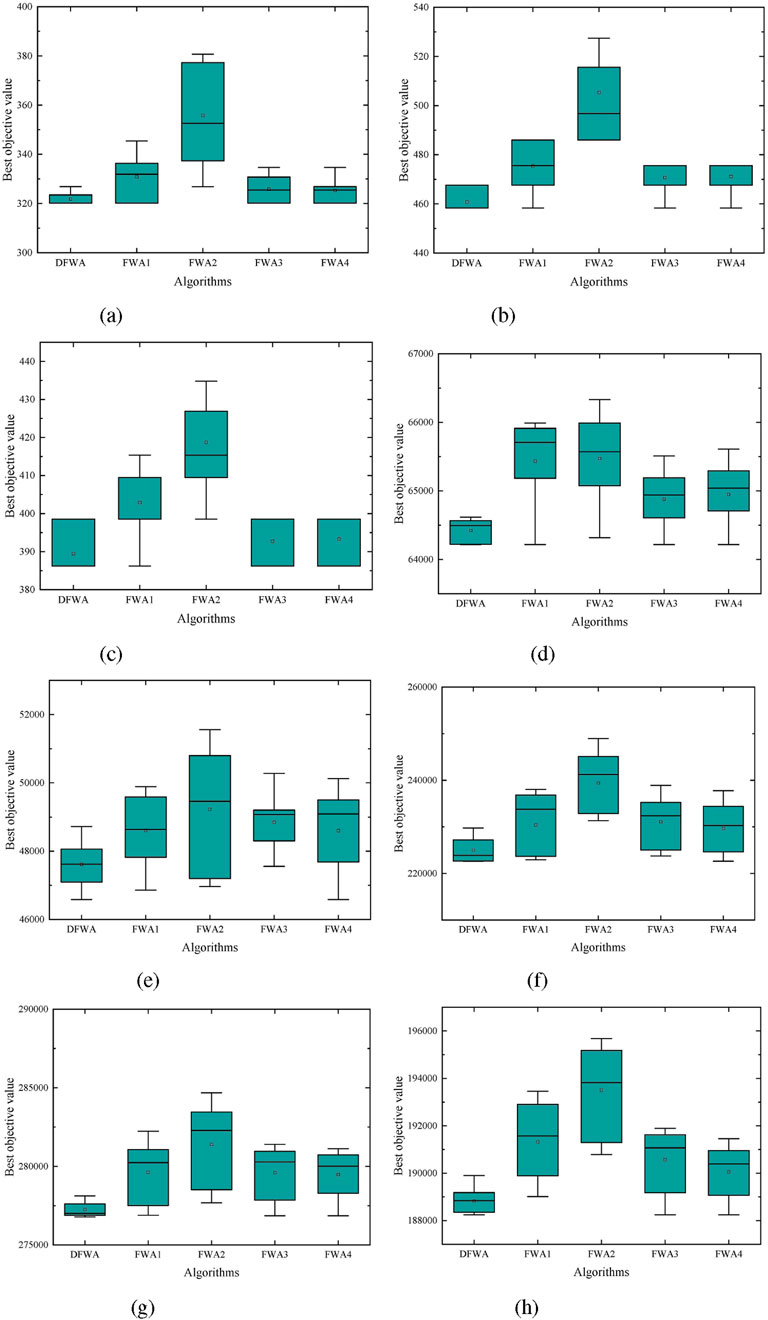
Figure 10. Box plots of DFWA, FWA1, FWA2, FWA3, and FWA4 on four small instances. (a) Gaskell67-21 × 5. (b) Gaskell67-22 × 5. (c) Gaskell67-29 × 5. (d) 50-5-1. (e) 50-5-3b. (f) 100-5-1. (g) 100-10-1. (h) 100-10-3b.
Moreover, Table 7 also suggests that DFWA seems more stable than the four variants, as also reported through the box plots in Figure 10 portraying the results of the five FWAs on eight instances.
4.3 Benchmarking our DFWA
To assess the performance of our DFWA in solving OCLRPs, we obtained 33 instances from the corresponding CLRP benchmark instances, solved them, and compared their results with those in Yu and Lin (2015) and their best-known solution.
Table 8 presents the benchmark results obtained by solving the OCLRP with CPLEX and the best-known CLRP solution. Each row provides the number
Some might question whether the objective function values between the CLRP and OCLRP are comparable. After all, the OCLRP vehicle costs should differ from those in the CLRP, since the vehicles in the OCLRP are leased and are thus not owned by the company. However, the objective values in Table 8 are only used to explain that the logistics costs of the OCLRP are lower than those of the CLRP when vehicle costs are the same. In reality, should the logistics costs of the TPL company be lower than the logistics cost of the company’s own distribution, the company would outsource its logistics activities to the TPL provider. Otherwise, the company would not outsource such activities. This provides a decision-support argument in relation to outsourcing logistics.
As Table 8 shows, CPLEX finds feasible solutions for all 33 instances, with 16 of them optimally solved within 14,400 s. However, the computing time grows considerably with instance size. For 26 out of 33 test instances, CPLEX provided lower objective values than the corresponding CLRP instances. Such value difference could suggest potential benefits of outsourcing logistics (Yu and Lin, 2015). In particular, we can observe that the percentage deviation from the best-known objective value of the CLRP varies from −13.38% to −31.09%, indicating that the OCLRP can save important costs by outsourcing logistics (about 19.33% for the above-mentioned 26 instances).
Table 9 compares the results attained over the 33 OCLRP instances with our DFWA and SA—a powerful state-of-the-art heuristic algorithm for solving the OCLRP (Yu and Lin, 2015). As mentioned, the OCLRP has been significantly less investigated in the literature. Thus, we only compare the proposed algorithm with a heuristic in our study, as it is difficult to find other heuristic algorithms used to solve the OCLRP. Besides the objective value (Obj.) and CPU time spent by both algorithms, the table also provides the percentage deviation from the best-known solution of the CLRP
From Table 9, we appreciate that SA and DFWA obtained the same results in 23 instances, whereas DFWA produced better solutions (and lower percentage deviations) in the remaining ten. Moreover, the average percentage deviations (
Moreover, the results presented in Tables 7 and 8 enable a comparison between our DFWA and the CPLEX implementation. DFWA provides the same or better solutions. On the other hand, CPLEX spent slightly less computational time than our DFWA in most instances, with the number of customers smaller than 32. However, for instances with 50 or more customers, CPLEX spent much more computational time, and our DFWA provides better solutions within less than 330 s. The average computational time spent by CPLEX is about 8,256.21 s—much longer than DFWA’s average 117.56 s. Thus, compared to CPLEX and SA, our DFWA seems to provide good solutions in a reasonable time for large-size OCLRP instances.
We also performed non-parametric Friedman and Wilcoxon signed-rank tests (at a significance level 0.05) to assess the statistical significance of the observed differences between DFWA and SA based on the
4.4 A real case
Given the successful benchmarking of our DFWA for OCLRP, we tested it in a real case for a company that delivers to fruit and vegetable supermarkets in Shanghai, China. This company has been using five 12-ton capacity vehicles for daily distribution of merchandise from two depots to 16 supermarkets in the city. The transportation and monthly fixed costs (including only monthly depreciation) are, respectively, 5 Yuan per kilometer and 1,000 Yuan. Table 10 presents the current five distribution routes and monthly delivery costs (covering routing, fixed vehicle, depot rental costs). Depots are numbered 1 to 4 (the current two, plus an additional two), with their features in Table 11, and supermarkets are numbered 5 to 20.
In order to strengthen its competitive ability and save distribution costs, this company considers optimizing its logistics system. Besides the two current depots, two additional potential depots numbered 3 and 4 are contemplated. Figure 11 illustrates the locations of the depots and the supermarkets. Table 12 shows the daily demand of these. Table 13 lists the distances between each pair of points. The company needs to determine which depots from the four candidates should be open to provide service to the 16 supermarkets and whether it should outsource its delivery activities to a TPL company.
We solve the corresponding OCLRP and CLRP with our DFWA with results in Table 14. Compared with Table 10, we observe the differences between the current distribution routes and those obtained using the OCLRP and CLRP formulations. These two not only suggest the same open depots (2 and 3) but also produce the same number of distribution vehicles (six). However, as the last row in Table 14 shows, the monthly delivery cost using OCLRP is 82965 Yuan, which is less than 93030 Yuan produced with the CLRP formulation. The savings with respect to the current distribution routes are
The same transportation and fixed vehicle costs are used for OCLRP and CLRP in the above discussion. We now analyze whether the company would still need to cooperate with a TPL provider should the unit transportation and fixed vehicle costs of the TPL company be larger than those used by the company-owned logistics. For different fixed vehicle costs, we obtained the same distribution routes shown in Table 14. Table 15 presents the monthly routing costs at different fixed vehicle costs for the OCLRP. As shown there, so long as the fixed vehicle costs are less than 2,700 Yuan, cooperation with a TPL provider seems a good option because the monthly delivery costs generated using OCLRP are less than the 93030 Yuan required if in-company logistics are used. However, when such costs are larger than 2,700 Yuan, it is better for the company to deliver the merchandise to the supermarkets through its own logistics.
5 Discussion
We have studied the OCLRP, a variant of the classical CLRP, in which vehicles do not return to distribution centers or depots after having served the customers, and we proposed an effective DFWA to solve the OCLRP. This algorithm includes repeated swap moves to strengthen local search and improve solution quality. Moreover, to guarantee fireworks diversity, we implemented not only insertion and inversion moves in the mutation process but also a fitness-and-Hamming-distance-based selection strategy to select the next-generation fireworks. To verify the performance of the proposed DFWA, an extensive numerical experiment was carried out with 33 benchmark CLRP instances. Numerical results suggest that the proposed algorithm is quite competitive compared with the best-published results both in terms of solution quality and computational time. In addition, the differences between the CLRP and OCLRP solutions are further illustrated through a real case study providing improved distribution routes as well as information to support logistics outsourcing decisions.
Several potential extensions for this work include (1) developing other variants of the OCLRP, such as OCLRP with time windows, multi-objective OCLRP, and OCLRP with stochastic or fuzzy demands; (2) designing other meta-heuristic algorithms to solve the OCLRP and its variants; and (3) adapting the DFWA to solve other variants of FLPs and VRPs.
Data availability statement
Publicly available datasets were analyzed in this study. The original contributions presented in the study are included in the article/supplementary material; further inquiries can be directed to the corresponding author.
Author contributions
HZ: Supervision, Project administration, Conceptualization, Methodology, Investigation, Data curation, Writing – original draft, Writing – review and editing, Formal Analysis. XZ: Methodology, Writing – review and editing, Formal Analysis, Writing – original draft, Data curation. DR: Investigation, Writing – review and editing, Writing – original draft, Methodology.
Funding
The author(s) declare that financial support was received for the research and/or publication of this article. The research was supported by the Humanities and Social Sciences Foundation of the Ministry of Education of China (Grant No. 21YJC630087) and the High-end Foreign Experts Recruitment Plan of China (Grant No. G2023013029). The work of David Rios Insua is supported by the Spanish Ministry of Science and Research program PID2021-124662OB-I00 and the AXA-ICMAT Chair in Adversarial Risk Analysis.
Acknowledgments
The authors would like to thank all individuals and organizations who contributed directly or indirectly to this study. We also appreciate the insightful comments and suggestions provided by colleagues during the research process.
Conflict of interest
The authors declare that the research was conducted in the absence of any commercial or financial relationships that could be construed as a potential conflict of interest.
Generative AI statement
The author(s) declare that no Generative AI was used in the creation of this manuscript.
Any alternative text (alt text) provided alongside figures in this article has been generated by Frontiers with the support of artificial intelligence and reasonable efforts have been made to ensure accuracy, including review by the authors wherever possible. If you identify any issues, please contact us.
Publisher’s note
All claims expressed in this article are solely those of the authors and do not necessarily represent those of their affiliated organizations, or those of the publisher, the editors and the reviewers. Any product that may be evaluated in this article, or claim that may be made by its manufacturer, is not guaranteed or endorsed by the publisher.
References
Arifuddin, A., Utamima, A., Mahananto, F., Vinarti, R. A., and Fernanda, N. (2024). Optimizing the capacitated vehicle routing problem at pqr company: a genetic algorithm and grey wolf optimizer approach. Procedia Comput. Sci. 234, 420–427. doi:10.1016/j.procs.2024.03.023
Bootaki, B., and Zhang, G. (2024). A location-production-routing problem for distributed manufacturing platforms: a neural genetic algorithm solution methodology. Int. J. Prod. Econ. 275, 109325. doi:10.1016/j.ijpe.2024.109325
Chen, Y., Li, L., Zhao, X., Xiao, J., Wu, Q., and Tan, Y. (2019). Simplified hybrid fireworks algorithm. Knowledge-Based Syst. 173, 128–139. doi:10.1016/j.knosys.2019.02.029
Dai, Z., Aqlan, F., Gao, K., and Zhou, Y. (2019). A two-phase method for multi-echelon location-routing problems in supply chains. Expert Syst. Appl. 115, 618–634. doi:10.1016/j.eswa.2018.06.050
Ding, R., Hu, S., Xing, Z., and Yan, T. (2025). Multi-type radar deployment for uav swarms defense coverage using firework algorithm with determinantal point processes under complex terrain. Appl. Soft Comput. 170, 112681. doi:10.1016/j.asoc.2024.112681
Erbao, C., and Mingyong, L. (2009). A hybrid differential evolution algorithm to vehicle routing problem with fuzzy demands. J. Comput. Appl. Math. 231 (1), 302–310. doi:10.1016/j.cam.2009.02.015
Farham, M. S., Süral, H., and Iyigun, C. (2018). A column generation approach for the location-routing problem with time windows. Comput. & Operations Res. 90, 249–263. doi:10.1016/j.cor.2017.09.010
Ferreira, K. M., and Alves de Queiroz, T. (2022). A simulated annealing based heuristic for a location-routing problem with two-dimensional loading constraints. Appl. Soft Comput. 118, 108443. doi:10.1016/j.asoc.2022.108443
Garcia-Diaz, A., and Smith, J. M. (2024). “Facility location models,” in Facilities planning and design (Cham: Springer Nature Switzerland), 149–188.
Garside, A. K., Ahmad, R., and Muhtazaruddin, M. N. B. (2024). A recent review of solution approaches for green vehicle routing problem and its variants. Operations Res. Perspect. 12, 100303. doi:10.1016/j.orp.2024.100303
Kechmane, L., Nsiri, B., and Baalal, A. (2018). A hybrid particle swarm optimization algorithm for the capacitated location routing problem. Int. J. Intelligent Comput. Cybern. 11 (1), 106–120. doi:10.1108/ijicc-03-2017-0023
Kyriakakis, N. A., Sevastopoulos, I., Marinaki, M., and Marinakis, Y. (2022). A hybrid tabu search – variable neighborhood descent algorithm for the cumulative capacitated vehicle routing problem with time windows in humanitarian applications. Comput. & Industrial Eng. 164, 107868. doi:10.1016/j.cie.2021.107868
Marques, G., Sadykov, R., Deschamps, J.-C., and Dupas, R. (2020). An improved branch-cut-and-price algorithm for the two-echelon capacitated vehicle routing problem. Comput. & Operations Res. 114, 104833. doi:10.1016/j.cor.2019.104833
Meng, X., and Tan, Y. (2024). Multi-guiding spark fireworks algorithm: solving multimodal functions by multiple guiding Sparks in fireworks algorithm. Swarm Evol. Comput. 85, 101458. doi:10.1016/j.swevo.2023.101458
Mohamed, I. B., Klibi, W., Sadykov, R., Sen, H., and Vanderbeck, F. (2022). The two-echelon stochastic multi-period capacitated location-routing problem. Eur. J. Operational Res. doi:10.1016/j.ejor.2022.07.022
Niu, Y. Y., Shao, J., Xiao, J. H., Song, W., and Cao, Z. G. (2022). Multi-objective evolutionary algorithm based on rbf network for solving the stochastic vehicle routing problem. Inf. Sci. 609, 387–410. doi:10.1016/j.ins.2022.07.087
Nucamendi-Guillén, S., Gómez Padilla, A., Olivares-Benitez, E., and Moreno-Vega, J. M. (2021). The multi-depot open location routing problem with a heterogeneous fixed fleet. Expert Syst. Appl., 165, 113846, doi:10.1016/j.eswa.2020.113846
Prins, C., Prodhon, C., and Calvo, R. W. (2006). Solving the capacitated location-routing problem by a grasp complemented by a learning process and a path relinking. 4(3), 221–238. doi:10.1007/s10288-006-0001-9
Shen, X., Xu, D., Song, L., and Zhang, Y. (2023). Heterogeneous multi-project multi-task allocation in mobile crowdsensing using an ensemble fireworks algorithm. Appl. Soft Comput. 145, 110571. doi:10.1016/j.asoc.2023.110571
Shi, Y., Zhou, Y., Boudouh, T., and Grunder, O. (2022). A memetic algorithm for a relocation-routing problem in green production of gas considering uncertainties. Swarm Evol. Comput. 74, 101129. doi:10.1016/j.swevo.2022.101129
Tan, Y. (2015). Fireworks algorithm: a novel swarm intelligence optimization method. Incorporated: Springer Publishing Company.
Tan, Y., and Zhu, Y. (2010). “Fireworks algorithm for optimization,” in Advances in swarm intelligence. ICSI 2010. Lecture notes in computer science. Editors Y. Tan, Y. Shi, and K. C. Tan (Berlin, Heidelberg: Springer), 6145, 355–364. doi:10.1007/978-3-642-13495-1_44Lect. Notes Comput. Sci.
Tan, D., Liu, X., Zhou, R., Fu, X., and Li, Z. (2025). A novel multi-objective artificial bee colony algorithm for solving the two-echelon load-dependent location-routing problem with pick-up and delivery. Eng. Appl. Artif. Intell. 139, 109636. doi:10.1016/j.engappai.2024.109636
Ting, C.-J., and Chen, C.-H. (2013). A multiple ant colony optimization algorithm for the capacitated location routing problem. Int. J. Prod. Econ. 141 (1), 34–44. doi:10.1016/j.ijpe.2012.06.011
Toro, E., Franco, J. F., Echeverri, M. G., Guimarães, F. G., and Gallego Rendón, R. A. (2017). Green open location-routing problem considering economic and environmental costs. Int. J. Industrial Eng. Comput. 8 (2), 203–216. doi:10.5267/j.ijiec.2016.10.001
Wang, Y., Sun, Y., Guan, X., Fan, J., Xu, M., and Wang, H. (2021). Two-echelon multi-period location routing problem with shared transportation resource. Knowledge-Based Syst. 226, 107168. doi:10.1016/j.knosys.2021.107168
Yu, V. F., and Lin, S.-Y. (2015). A simulated annealing heuristic for the open location-routing problem. Comput. & Operations Res. 62, 184–196. doi:10.1016/j.cor.2014.10.009
Yu, V. F., and Lin, S. Y. (2016). Solving the location-routing problem with simultaneous pickup and delivery by simulated annealing. Int. J. Prod. Res. 54 (2), 526–549. doi:10.1080/00207543.2015.1085655
Zhang, H. Z., Zhang, Q., Ma, L., Zhang, Z., and Liu, Y. (2019). A hybrid ant colony optimization algorithm for a multi-objective vehicle routing problem with flexible time windows. Inf. Sci. 490, 166–190. doi:10.1016/j.ins.2019.03.070
Zhang, H. Z., Zhang, K., Zhou, Y. Y., Ma, L., and Zhang, Z. Y. (2022a). An immune algorithm for solving the optimization problem of locating the battery swapping stations. Knowledge-Based Syst. 248, 108883–108883. doi:10.1016/j.knosys.2022.108883
Keywords: logistics, open capacitated location-routing problem, capacitated location-routing problem, fireworks algorithm, discrete
Citation: Zhang H, Zhou X and Rios Insua D (2025) Efficiently solving open capacitated location-routing problems through a discrete fireworks algorithm. Front. Ind. Eng. 3:1686126. doi: 10.3389/fieng.2025.1686126
Received: 14 August 2025; Accepted: 29 September 2025;
Published: 14 November 2025.
Edited by:
Mitsuo Gen, Tokyo University of Science, JapanReviewed by:
Wenqiang Zhang, Henan University of Technology, ChinaHiroaki Tohyama, Maebashi Institute of Technology, Japan
Copyright © 2025 Zhang, Zhou and Rios Insua. This is an open-access article distributed under the terms of the Creative Commons Attribution License (CC BY). The use, distribution or reproduction in other forums is permitted, provided the original author(s) and the copyright owner(s) are credited and that the original publication in this journal is cited, in accordance with accepted academic practice. No use, distribution or reproduction is permitted which does not comply with these terms.
*Correspondence: Huizhen Zhang, aHVpemhlbnpoYW5nQHVzc3QuZWR1LmNu
 Huizhen Zhang
Huizhen Zhang Xun Zhou1
Xun Zhou1

